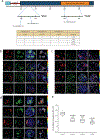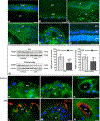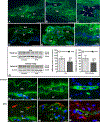Genetic association study of exfoliation syndrome identifies a protective rare variant at LOXL1 and five new susceptibility loci
- PMID: 28553957
- PMCID: PMC6685441
- DOI: 10.1038/ng.3875
Genetic association study of exfoliation syndrome identifies a protective rare variant at LOXL1 and five new susceptibility loci
Abstract
Exfoliation syndrome (XFS) is the most common known risk factor for secondary glaucoma and a major cause of blindness worldwide. Variants in two genes, LOXL1 and CACNA1A, have previously been associated with XFS. To further elucidate the genetic basis of XFS, we collected a global sample of XFS cases to refine the association at LOXL1, which previously showed inconsistent results across populations, and to identify new variants associated with XFS. We identified a rare protective allele at LOXL1 (p.Phe407, odds ratio (OR) = 25, P = 2.9 × 10-14) through deep resequencing of XFS cases and controls from nine countries. A genome-wide association study (GWAS) of XFS cases and controls from 24 countries followed by replication in 18 countries identified seven genome-wide significant loci (P < 5 × 10-8). We identified association signals at 13q12 (POMP), 11q23.3 (TMEM136), 6p21 (AGPAT1), 3p24 (RBMS3) and 5q23 (near SEMA6A). These findings provide biological insights into the pathology of XFS and highlight a potential role for naturally occurring rare LOXL1 variants in disease biology.
Figures




References
-
- Vesti E & Kivela T Exfoliation syndrome and exfoliation glaucoma. Prog Retin Eye Res 19, 345–68 (2000). - PubMed
-
- Ritch R & Schlotzer-Schrehardt U Exfoliation syndrome. Surv Ophthalmol 45, 265–315 (2001). - PubMed
-
- Leske MC et al. Factors for glaucoma progression and the effect of treatment: the early manifest glaucoma trial. Arch Ophthalmol 121, 48–56 (2003). - PubMed
-
- Ritch R, Schlotzer-Schrehardt U & Konstas AG Why is glaucoma associated with exfoliation syndrome? Prog Retin Eye Res 22, 253–75 (2003). - PubMed
Publication types
MeSH terms
Substances
Grants and funding
LinkOut - more resources
Full Text Sources
Other Literature Sources

